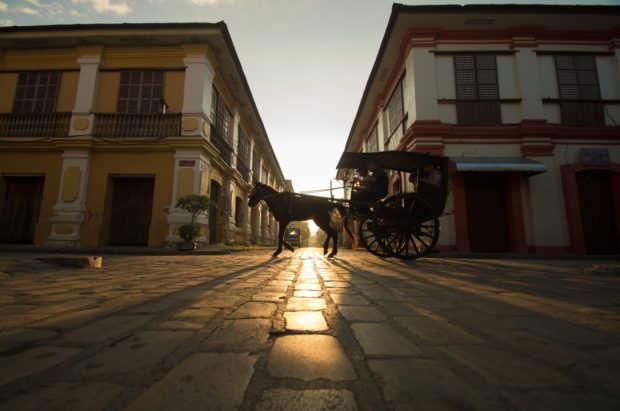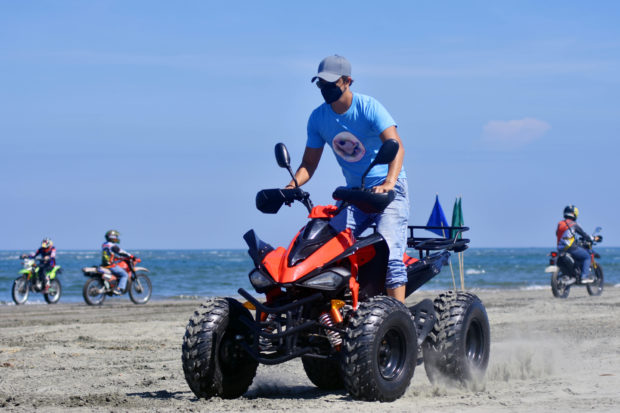DOT pushes nature, outdoor activities to revive Ilocos tourism

OLD WORLD CHARM The pandemic has battered the tourism industry in Ilocos Sur, including Vigan City, the province’s top tourist attraction due to the old world charm evoked by its heritage district featuring Spanish-era houses and cobblestone streets. Many “kutchero” (carriage drivers), like this man in this file photo, have lost their jobs during the health crisis. —RICHARD BALONGLONG
The Department of Tourism (DOT) said bicycle tours, motorbiking and other outdoor activities will be part of the recovery plan to spur local tourism in the Ilocos region.
Tourism Secretary Bernadette Romulo Puyat said that with the shift in local tourism preferences, tourists are now looking to incorporate outdoor activities like hiking and biking in their leisure travel.
Puyat said that as a response to the changing traveler preferences, the DOT has its eyes on developing new biking and motorbiking trails in the Ilocos, such as “Find the One Bike Tour” and “Motorismo,” with trails through the provinces of Pangasinan, La Union, Ilocos Norte and Ilocos Sur.
“Region 1 holds so much potential to appeal to tourists under the new normal, given its abundance in nature sites. That is why we are very excited to launch the tourism recovery plan that will introduce new and exciting activities that will provide additional opportunities for the micro, small and medium enterprises in the region,” Puyat said in a statement.
Other tourism recovery initiatives of the DOT in the Ilocos include the Marian pilgrimage tour; specialized training for “inabel” textile weavers in Ilocos Sur; bird watching in Ilocos Norte; and the development of eco and nature trails in La Union, among others.
Article continues after this advertisementVigan welcomes visitors
The provincial government of Ilocos Sur lifted the age restriction for tourists to encourage visitors from its traditional markets, which include those who travel with their families or groups of friends, to help revive the local tourism industry. Ilocos Sur is currently under the least stringent modified general community quarantine (MGCQ).Michael Ryan Astom, provincial tourism officer, told the Inquirer in a phone interview that Vigan City, llocos Sur’s main tourist drawer, and the entire tourism industry in the province continued to suffer from restricted leisure travel due to the pandemic.
Article continues after this advertisementAstom said the province had lost at least P1 billion in potential revenues from tourism-related activities amid the health crisis.
Vigan, a heritage site recognized by the United Nations Educational, Scientific and Cultural Organization, was placed under a modified enhanced community quarantine (MECQ) from May 22 to June 19, and barred the entry of tourists. MECQ is the second most restrictive form of quarantine in the country.

OUTDOOR ADVENTURE The Department of Tourism is banking on outdoor activities, like ATV (all-terrain vehicle), bike and motorcycle rides by the beach in Lingayen, Pangasinan, to revive the tourism industry in the Ilocos region. —WILLIE LOMIBAO
On June 20, Vigan reverted to general community quarantine, the second least restrictive quarantine classification, and started welcoming tourists of all ages. Indoor and outdoor tourist attractions in the city were allowed to operate at a 50-percent venue capacity.
High test costs
Tourists, he said, “felt discouraged to travel due to the high cost of COVID-19 testing, and families cannot travel together because they would need to leave their young children and old folks at home because of the age restrictions.”
“A family of four would even need to spend at least P14,000 in COVID-19 swab testing just to be able to travel for leisure,” he said.
Visitors, except for children age 3 and below, would still be subjected to health protocols and must present negative results from reverse transcription-polymerase chain reaction tests taken within 72 hours prior to their arrival at the provincial border.
A rapid antigen test taken 24 hours upon arrival at the border would be accepted only for tourists coming from areas under MGCQ.
In 2020, the province recorded 415,447 total visitors, with most arrivals in January and February or before the governmen imposed lockdowns and quarantine.
The low tourist arrivals in the province, with only 181 recorded so far since January this year, had displaced at least 8,000 workers in souvenir shops, hotels, restaurants and tour guides, among others, local data showed.